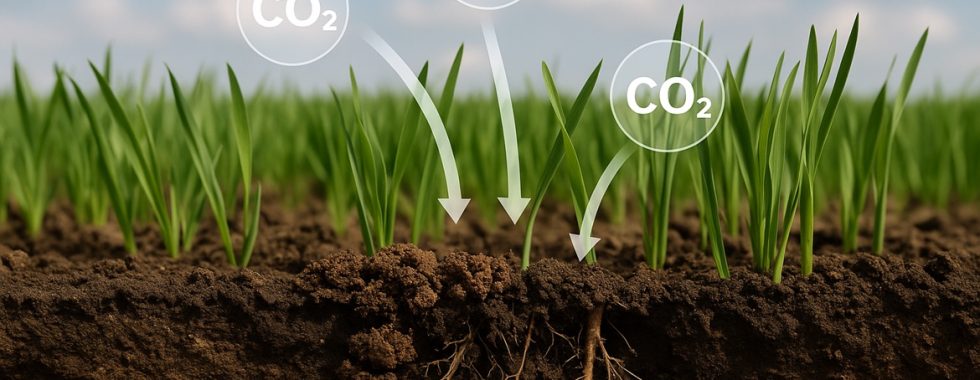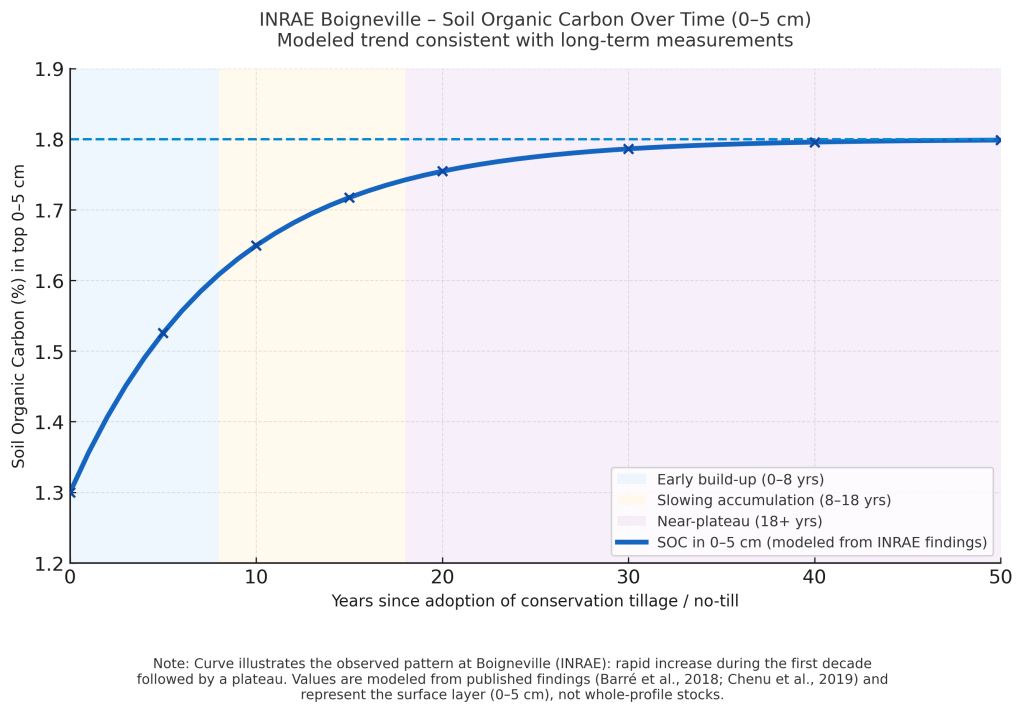Carbon Sequestration: A Reality Check
Carbon sequestration in agriculture is often presented as a win for the climate, soil, and farm economics. But for those managing real fields, it’s worth asking: how much carbon can realistically be stored, how stable is it, and does it make sense financially?
The short answer: soils can build up some carbon, but the process is slow, limited, and only makes financial sense when tied to better agronomy or supported by external programs.
How much carbon can soils actually store?
Soil organic carbon (SOC) depends mainly on soil texture, climate, and management. Most cultivated soils contain 0.5–2.5% SOC in the top 20 cm. Each 0.1% increase represents about 2.5–3.0 t C ha⁻¹, or 9-11 t CO₂ ha⁻¹.
Results from long-term trials
Decades of research show how limited carbon accumulation can be once soils reach balance. For example, in a long-term INRAE trial at Boigneville, France, soil carbon was monitored under conventional, reduced, and no-till systems for 47 years. After nearly five decades, researchers found no measurable increase in total SOC to 30 cm depth. The surface 0-5 cm contained more carbon under no-till, but this was offset by lower carbon deeper in the profile. The study concluded: “After 47 years, no significant difference in total SOC stocks was detected between conventional tillage and no-till treatments.” (Barré et al., 2018)
This pattern matches results from other long-term experiments (Rothamsted in the UK, Kellogg Biological Station in the US), all showing early carbon gains during the first decade, followed by a long plateau as soils stabilize.
Under improved management such as reduced tillage, residue retention, diverse rotations, and organic inputs, annual carbon gains typically range from:
- 0.2-0.5 t C ha⁻¹ yr⁻¹ (≈0.7-1.8 t CO₂ ha⁻¹ yr⁻¹) in semi-arid conditions
- 0.5-1.0 t C ha⁻¹ yr⁻¹ (≈1.8-3.7 t CO₂ ha⁻¹ yr⁻¹) in temperate, humid climates
- Rarely more than 1.5 t C ha⁻¹ yr⁻¹ (≈5 t CO₂ ha⁻¹ yr⁻¹) even under excellent management
Carbon gains slow down over time as the soil reaches a new balance. Most fields level off after 10-20 years of consistent practice. There’s no evidence that cropland can store tens of tons of carbon per hectare per year without major land-use change.
Agronomic effects and trade-offs
Practices that build SOC usually make soils more resilient and productive, but they also shift how the system behaves. The changes are generally positive, yet each one comes with something to watch out for.
-
-
- Nutrient availability. Microbes and fresh organic matter tie up part of the nitrogen and sulfur as soil biology becomes more active. It’s part of the natural cycle, but in the short term, crops can feel that shortage. In high-residue systems or after cereal crops, a small early dose of nitrogen or adjusted timing can keep plants from running short.
- Water balance. Cover crops and residue protect the soil surface, slow runoff, and improve infiltration. But they also use water. In dry years or sandy soils, the cover crop might leave the profile drier than expected. The key is to match termination timing and species choice with the local rainfall pattern.
- Residue load. Thick residue keeps moisture and prevents crusting, but it can also cool the soil and make seeding tricky. In some systems it raises the risk of residue-borne pests and diseases. Good rotation, residue spreading, and occasional light disturbance usually keep things in balance.
- Losses after disturbance. Once the soil is tilled, compacted, or left bare, carbon losses start almost immediately. Microbes get oxygen and temperature rises, speeding up decomposition. Even a single tillage pass or a season of bare fallow can reverse several years of slow gains. Maintaining residue cover and minimizing traffic best preserve the carbon that’s been built up.
-
Overall, SOC-building systems work, but they need close management. Nutrients, water, and residue dynamics all change once biological activity increases, and those shifts need to be tracked like any other agronomic factor.
Economics under current market conditions
Take a field that builds up about 2 t CO₂ ha⁻¹ yr⁻¹, which is a good result for cropland. Current voluntary carbon markets pay roughly 10-35 USD per t CO₂, depending on verification and buyer. Using an average of 25 USD per t CO₂, potential income is about 50 USD ha⁻¹ yr⁻¹.
Costs are usually higher:
- Measurement and verification: 10–20 USD ha⁻¹ yr⁻¹.
- Extra seed, fuel, and management for cover crops or reduced tillage: 40–60 USD ha⁻¹ yr⁻¹.
At those numbers, the economics are marginal. Carbon credits don’t cover the real cost of changing practices. The main financial benefit comes indirectly—from better soil structure, less erosion, and higher efficiency of fertilizers and irrigation.
Practical challenges of long-term programs
Soil carbon changes slowly, while farm planning works on short cycles. That mismatch causes problems.
Most carbon programs expect 10-20 years of “permanence,” but land tenure, cropping plans, and market conditions rarely stay fixed for that long. Farmers may lease land for only a few seasons or need to till a field occasionally to control weeds.
Carbon programs also require measurements to be done the same way every time — same plots, same depth, same timing. In reality, farming doesn’t happen under controlled conditions. Weather shifts, rotations change, and market pressures can alter management. These variations make consistent tracking difficult and can lead to data that looks inconsistent even when the farmer is doing things right.
A more practical approach is to use renewable five-year agreements, verified by a mix of sampling and modeled data. This keeps programs accountable but allows flexibility for farmers to adapt to real conditions without losing eligibility or credibility.
Who pays for it?
At present, most of the cost sits with the grower. The main funding routes are:
-
-
- Corporate supply chains. Some food and beverage companies pay suppliers small premiums or co-finance cover crops to reduce their Scope 3 emissions. These payments usually cover part of the cost, not all of it.
- Government support. Some programs subsidize conservation tillage or cover crops. Useful, but budgets are limited and vary by region.
- Voluntary carbon markets. Workable for large aggregations of land but not yet efficient for individual farms because verification is expensive.
- Internal accounting. Large integrated agribusinesses sometimes count soil carbon gains as internal emission reductions. It helps compliance but doesn’t generate cash.
-
To scale up adoption, growers, processors, and consumers need to share costs and benefits costs and benefits need to be shared more evenly.
Why measurement matters
Even if credit revenue is small, reliable soil carbon data has value. Baseline measurements and follow-up tests help track soil improvement, refine fertilizer management, and document sustainability performance for supply-chain reporting or finance access.
In that sense, SOC is better treated as a performance indicator, a measure of how well the soil is managed, rather than as a product that can be traded year after year.
Realistic expectations
Across well-managed cropping systems, an increase of 0.1-0.3 percentage points SOC over 10-15 years is achievable. That equals about 10-30 tons of CO₂ per hectare over that period. It’s meaningful for soil health but small in financial terms.
Carbon programs can help offset some transition costs, but profitability will continue to depend mainly on yield, input use, and water efficiency. Farmers should integrate carbon improvements into overall management rather than treating them as a separate project.
To conclude, biological, temporal, and economic limits define the true potential of soil carbon sequestration.
-
-
- Realistic sequestration: 0.5-1.5 t CO₂ ha⁻¹ yr⁻¹
- Typical credit price: 10-35 USD t⁻¹ CO₂
- Additional management and verification cost: ≈50-80 USD ha⁻¹ yr⁻¹
-
At today’s prices, carbon income is minor. The real and lasting value lies in better soil function, improved water management, and stronger resilience under variable weather.


